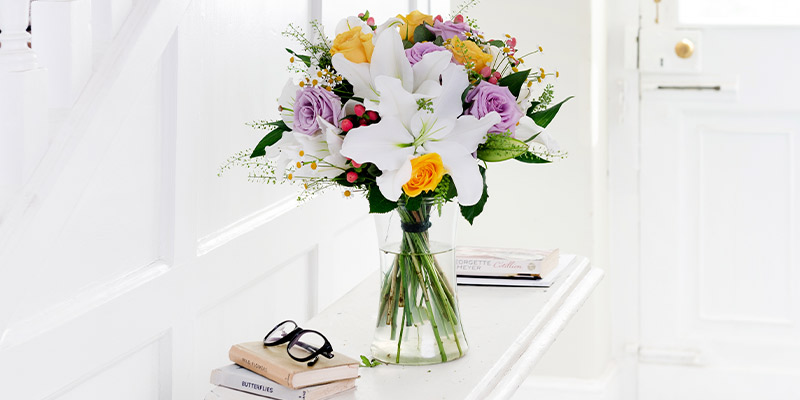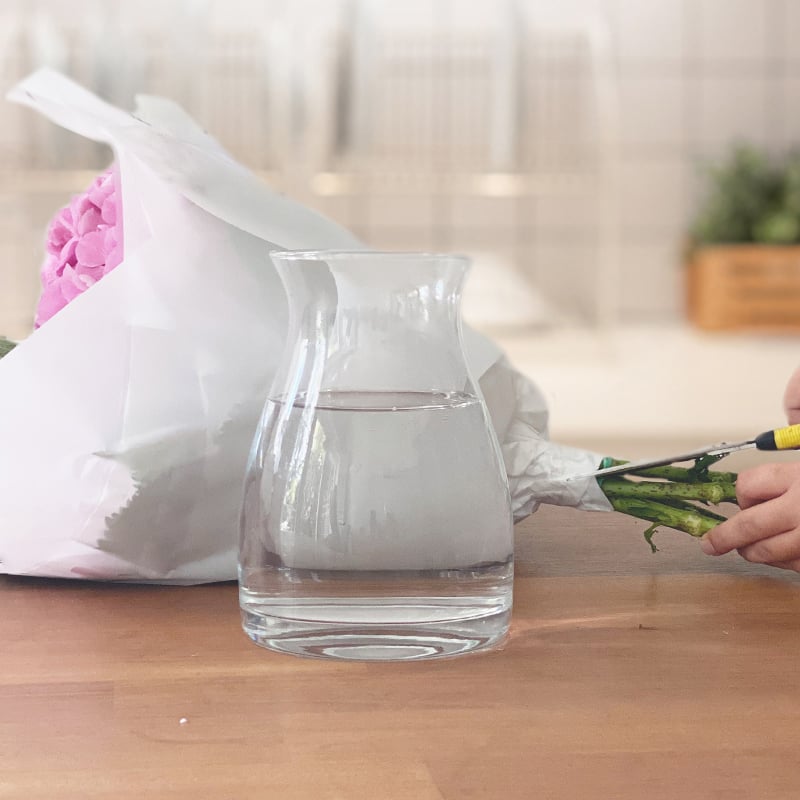
It’s a sad fact that cut flowers don’t last forever, but with a bit of green-fingered know-how, you can keep your blooms looking beautiful for longer.
How to Keep Cut Flowers Fresh
Don't forget that all of our flowers have at least 5 days freshness guaranteed - but there are some easy ways to have your blooms last for even longer!
Firstly, there are a few simple rules that apply to all (or almost all!) species:
1. Fill your vase with water
Choose a vase that suits the bouquet - for example, a tall slender vase works well to support tall or top heavy stems. Then, fill your vase with fresh, room temperature water that’s neither hot nor icy cold.

2. Add flower food
Stir in some flower food, which we supply with all of our bouquets. This helps replace the nourishment the flowers would have got from the soil, while keeping the water clear and bacteria-free.
You can also make your own flower food by mixing two tablespoons of apple cider vinegar and two tablespoons of sugar into one litre of water. Blending one teaspoon of sugar with a few drops of bleach, vodka or another clear spirit is another tried and tested substitute, as is ¼ cup of fizzy lemonade. Others swear by copper coins and crushed aspirin, both of which lower the water’s pH level (making it more acidic) so that it can travel up the stems more quickly and prevent wilting.
Whatever method you try, be sure to refresh the water and flower food every few days.

3. Prepare your blooms
Cut at least 2cm (about an inch) off the end of each stem at a 45-degree angle. This maximises the surface area, allowing for greater water intake, and stops them sitting flat against the bottom of the vase. Use sharp scissors so as not to crush the stems, and re-trim them every few days.
Remove any leaves that will be underwater in the vase, else they will rot and release bacteria.

4. Display your flowers
Position your vase away from the fruit bowl! Ripening fruit gives off a gas called ethylene that shortens a flower’s life, with bananas the biggest culprits.
Keep your display out of direct sunlight, which can scorch the petals, and away from chilly draughts and heat sources, both of which can lead to dehydration.
Putting your display in the fridge every night has been proven to slow ageing and extend its lifespan, but who has room in their fridge for a vase full of flowers?!

Flower Care Tips
Next, let’s run through some top tips for making specific species last longer.
Roses
Roses are known for their transience, but they can last up to 12 days with proper care. They’re a thirsty species that thrive in deeper, lukewarm water.
Don’t cram too many stems into a vase; roses need space to open up (our bouquets arrive in bud for longevity) and are prone to premature moulding if kept too close together.
Did you know that those browning, sad-looking outer petals are called guard petals, and are meant to be removed? They’re only there to protect the fragile rose bud. Gently peeling them off won’t kill your flowers, it’ll make them look prettier for longer!

Lilies
Hands up who’s had their jumper stained yellow by lily pollen? We’ll bet that’s all of you. Interesting, a lily’s petals hate its pollen too! It erodes any petals it touches, reducing the flower’s lifespan. The pollen on stargazer lilies is the easiest to remove as it lives on stamens that protrude from the centre of the flower and can gently be picked off.
Peonies
Cut peonies from your garden while they’re still in bud, and look for bouquets that deliver in bud, too (ours always do). They’ll slowly start to unfurl over the first few days in your vase. Sometimes they’ll fail to open. If this happens, hold each stem under gently running room temperature water, which will remove any sap that may be keeping them glued shut.

Hyacinths
Hyacinths grow from bulbs, meaning stems can be a little sandy. Wash them carefully before popping them into a tall vase (they’re top heavy and need support) , so as not to muddy the water. That said, the water will still get cloudy because hyacinths release a sap. Get around this by changing the water more regularly than you usually would - daily, if possible. Hyacinth sap will shorten the life span of other flowers, so either stick to a single-species display, or put your hyacinth stems into another vase for 12 hours to release some sap first. Better still, don’t cut hyacinths at all! Leave the basal plate intact or enjoy them as a pot plant.
Hydrangeas
Hydrangeas are very thirsty flowers. We deliver ours in hydration boxes to keep them happy, but plunge them into water straight after unwrapping to keep them from wilting. Choose a wide-rimmed vase that’ll give the big flower heads enough space to thrive. Top the water up regularly and spray the petals for extra hydration in between replenishes.

Sunflowers
Sunflowers have huge flower heads that may droop over if not given enough support. Keep them upright by displaying them in a tall vase. They tend to arrive with more foliage than other species, so be sure to remove any leaves below the water line. Sunflowers need plenty of water, so keep the vase full and fresh for maximum enjoyment.
Tulips
Tulips continue to grow after cutting, so choose a tall vase that’ll support the stems and keep them from drooping and snapping. Retrim the ends when necessary. Tulips naturally bend towards the sun, so rotate the vase every couple of days.

Orchids
Orchids have a reputation for being high-maintenance, and they can be, but the rewards are worth the extra effort. They’re a tropical plant, so their preferred conditions (generally hot and humid) can be tricky to replicate. There are 25,000 varieties of orchid, all with differing needs, so Google yours to find out what it likes best.
To maintain the colourful blooms, regularly trim any dead leaves and decaying petals. You’ll know that your orchid is getting enough light if its leaves are bright green.
Once a potted orchid’s flowers have fallen off, repot it into nutrient-rich soil to encourage more growth. If it’s leaves have wilted, or if it’s small in stature, cut the stem at the base to give it time to recover before blooming again. Water and fertilise it to build it back up for further flowering on a new stem.
Cut orchids are a great choice for bouquets too, with their showy and long-lasting blooms making fantastic statement stems. We send ours cut short in hydration vials, which shouldn't be removed. You can snap the vials to the right length to match your vase, and refill the water every few days to keep your orchids happy and hydrated.
Long Lasting Flowers
Lastly, make a note of naturally long-lasting flowers. Here are a few of our favourites, which should last according to the time period shown in brackets, if you follow the basic care tips above:
- Chrysanthemums (2-4 weeks)
- Orchids (2-3 weeks, or up to 3 months as a pot plant)
- Carnations (2-3 weeks)
- Zinnias (2-3 weeks)
- Alstroemeria (2 weeks)
- Delphiniums (2 weeks)
- Eryngiums (2 weeks)
- Lilies (10-14 days)
- Sunflowers (12 days)
- Gladioli (12 days)
- Freesias (10 days)
- Hydrangeas (7-10 days, or over a year if left to dry!)
Dead set on gifting a flower that’ll last forever? Look for preserved flowers, which have had their natural sap replaced with a glycerine solution to keep them looking fresh and feeling soft for up to a year. Our romantic forever rose is a stunning example, and the next best thing to magic.
Thinking of gifting an Appleyard bouquet? Good choice, if we do say so ourselves. Our flowers are covered by our 5-day happiness guarantee, so you can rest assured that your lucky recipient will enjoy them for at least a week, if not longer! Flower care tips are included with every bunch, and we leave excess leaves and petals on the stems to help prevent damage during delivery. Shop our collection today.







